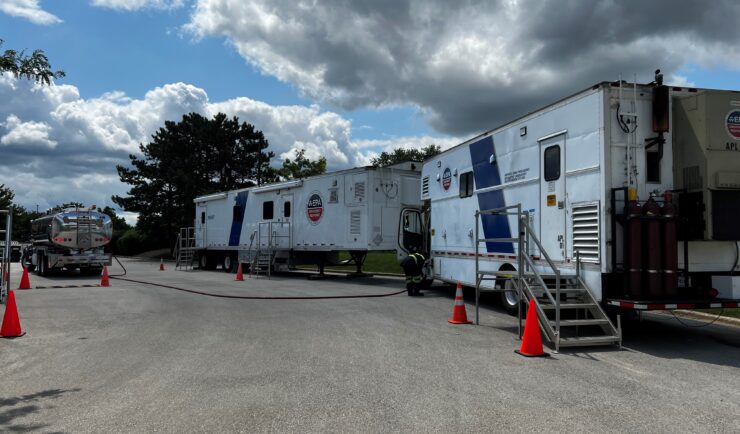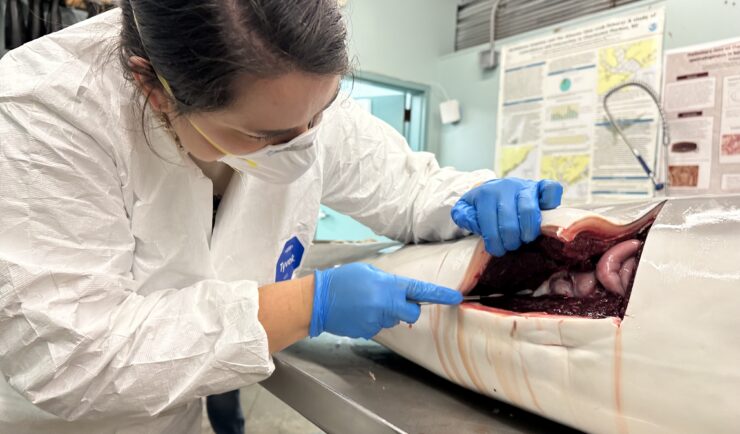- Success Stories
- Environmental Resource Assessment & Management
Examining Cetaceans for Contamination and Pathogens
CSS has employee owners who are experts in monitoring cetacean health. Several CSS scientists supporting NOAA’s Centers for Coastal Ocean Science have recently conducted research and tests on marine mammals to explore uncommon behaviors and causes for strandings. View some examples of this research below.
Microplastics are becoming increasingly abundant in coastal and marine environments. A CSS marine mammal microplastics specialist is monitoring microplastic abundance and types in the gastrointestinal tracts of stranded cetaceans. Since 2022 our specialist has processed over one kilometer of intestines from 53 marine mammals, most of which have been Tamanend’s bottlenose dolphins (Tursiops erebennus) local to the Charleston Harbor Estuary. Our specialist has discovered microplastics in every marine mammal tested to date, with the most common plastic being polypropylene fibers, a plastic commonly used in fishing nets, construction materials, textiles, and other synthetic products.

CSS scientists are using unoccupied aerial systems (UAS), also known as drones, to collect blow exhalation samples from Tamanend’s bottlenose dolphins in the Charleston Harbor Estuary. Over the past 20 years, these dolphins have been observed moving from waters with higher salinity to waters with low salinity, often needing rescuing and displaying poor health conditions. Using a UAS equipped with petri dishes enables scientists to monitor the respiratory health of dolphins at low cost in a non-invasive manner. Through these collections, CSS scientists are screening samples for respiratory pathogens and have screened more than 40 samples to date.

When the South Carolina Department of Natural Resources discovered a beached 43 ft sperm whale in Bulls Bay along the South Carolina coast, CSS cetacean specialists jumped to action. They assisted the Lowcountry Marine Mammal Network with the field response and partial necropsy by transporting supplies to the site, taking measurements, recording data, and collecting samples to understand what may have caused the death of this animal. The team examined the whale’s stomach and intestines for potential plastic ingestion.Throughout the examination, the team did not discover (macro)plastics within the cetacean’s digestive tract.
See More CSS Insights

Emergency Response Support for the Republican National Convention
CSS employee owners on contract with the U.S. Environmental Protection Agency’s Portable High-throughput Integrated Laboratory Identification System — a mobile analytical unit known as PHILIS — provided emergency response support for the 2024 Republican National Convention. PHILIS mobile laboratory units are designed to provide onsite analysis of environmental conditions, including air and soil samples, contaminated…

Assisting South Carolina Marine Mammal Stranding Network
CSS employee owner and Marine Mammal Microplastic Specialist supporting NOAA’s National Centers for Coastal Ocean Science assists the South Carolina Marine Mammal Stranding Network in responding to dead marine mammals when they strand on beaches or estuaries throughout South Carolina. This is work is critical for human and environmental health because it provides invaluable samples…

New Contract. Same Great Work.
We’re pleased to announce a new small business joint venture with Paul Bechtel & Associates (PB&A), which was awarded a 5-year contract to continue supporting the U.S. Environmental Protection Agency’s (EPA) Office of Pesticide Programs. For 40 years our staff have supported EPA’s Office of Pesticide Programs in the review and evaluation of pesticide data.…
